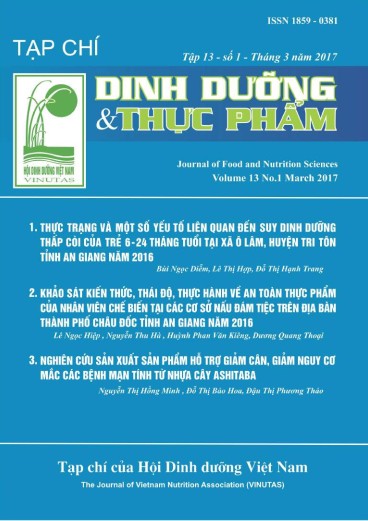STUDY ON THE PRODUCTION OF FUNCTIONAL FOOD SUPPORTING WEIGHT LOSS AND CHRONIC DISEASE RISK REDUCTION FROM ASHITABA SAP
Main Article Content
Abstract
Ashitaba sap contains chalcones – A yellow substance with high biological activities.
Two main chalcones in ashitaba sap are "Xanthoangelol" and "4-Hydroxyderricin". These
chalcones have myriad health benefits, which are to support the reduction of body weight
and risks of chronic diseases. Hard capsules, which are used to support body weight loss
and reduction of chronic diseases risk of adults at risk of overweight/obese, with a BMI>
23, are produced from the main material – ashitaba sap powder (containing 8% chalcones)
and Vitamin C, D, E, β-carotene. Hard capsule contains: Xanthoangelol: 4 mg; 4-hydroxyderricin: 2.2 mg Vitamin C: 35 mg; Vitamin D: 200 IU Vitamin E: 3 mg; β -carotene: 3
mg. This research has identified the formula of AO NIN premix (mixture of vitamins C,
D, E, β-carotene), identified manufacturing recipe: 16% ashitaba sap powder, 42% AO
NIN premix, 39% anhydrous lactose, 2% magnesium stearate , 1% talc and mix optimization method: mixing ashitaba sap powder with lactose anhydrous ashitaba first, then mixed
with Premix and slippery.
Keywords
Ashitaba, Chalcone, obesity, chronic diseases
Article Details
References
2 Nguyễn Công Khẩn, Lê Bạch Mai (2007). Thừa cân - Béo phì và một số yếu tố liên quan ở người trường thành Việt Nam 25 -60 tuổi. NXB Y học 2007.
3 Tatsuji Enoki (2007). Antidiabetic activities of Chalcones Isolated from a Japanese Herb, Angelica Keiskei. Journal of Agricultural and Food Chemistry, 55(15):6013-17.
4 Kyuichi Kawabata (2011). Prenylated Chalcones 4-hydroxyderricin and Xanthoangelol stimulate glucose uptake in skeletal muscle cells by inducing GLUT4
translocation. Molecular nutrition and food research, 55(3):467-75.
5 Hiromu Ohnogi (2012). Efficacy and Safety of Ashitaba (Angelica Keiskei) on the patients and candidates with Metabolic syndrome: A pilot study. Japanese journal of complementary and Alternative Medicine, 9(1):49-55.
6 Aasheim ET, Hofso D, Hjelmesaeth J, Birkeland KI, Bohmer T (2008). Vitamin status in morbidly obese patients: a crosssectional study. Am J Clin Nutr.;87:362–369.
7 Villaca Chaves G, Pereira SE, Saboya CJ, Ramalho A (2008). Nonalcoholic fatty liver disease and its relationship with the nutritional status of vitamin A in individuals with class III obesity. Obes Surg;18:378–385.
8 Viroonudomphol D, Pongpaew P, Tungtrongchitr R, et al (2013). The relationships between anthropometric measurements, serum vitamin A and E concentrations and lipid profiles in overweight and obese subjects. Asia Pac J Clin Nutr.;12:73–79.
9 Vimaleswaran K.S, Berry D.J, Luetal C (2013). Causal relationship between obesity and vitamin D status: bi-directional Mendelian randomization analysis of multiple cohorts. PloS Medicine,vol. 10, no. 2, Article ID e1001383.
10 García O.P, Kurt Z Long and Jorge L Rosado. Impact of micronutrient deficiencies on obesity. Nutrition Reviews, 67 (10): 559 – 772.


